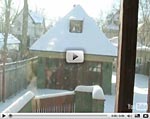List Price: $1.295 million
The Property: This house, one of a trio that Frank Lloyd Wright designed in his off-hours while employed by Louis Sullivan in the early 1890s, has been extensively renovated and expanded, all with a careful eye on the home’s history…
List Price: $1.295 million
The Property: This house, one of a trio that Frank Lloyd Wright designed in his off-hours while employed by Louis Sullivan in the early 1890s, has been extensively renovated and expanded, all with a careful eye on the home’s history.
In 1892, Wright designed this house and its twin for the Oak Park real-estate developer Thomas Gale; today it is just a block west of the architect’s now famous home and studio, which he had begun three years earlier. (The third house in the trio, not a visual triplet, came a year or two after the twins.) The house is a Queen Anne with a distinctly Wright twist: its big front and rear turrets and other details are tightly geometrical instead of broadly rounded, which was the norm for Queen Annes.
Only two families owned the house before 2004, when the builder and preservationist Rick Easty bought the place—for a price that is not recorded in public records—and launched a top-to-bottom renovation. “The idea was to salvage everything and put the house back in its original condition as much as possible,” says Nancy Vert, the Urban Search agent who is representing the house for Easty. “It was in disastrous shape then: it hadn’t been lived in for a few years, and the plumbing had been let go. But underneath all that was this Frank Lloyd Wright house.”
With the approval of landmark authorities, Easty removed a wall to open up the old-time layout of small rooms into a contemporary-sized living room; removed a side porch to make way for a driveway and rear garage; and added an “off-footprint” (a.k.a., not interfering with the original) piece that contains a new kitchen and, upstairs, the master bath.
Otherwise, the house feels like a period piece. The entry hall has a handsome Wright-style built-in bench, the main living rooms have Wright’s characteristic banded moldings on their walls, and Easty, in his effort to stay true to Wright’s intentions, has found new uses for the original windows, flooring, and even a bathtub. To compensate for the side porch he removed, he built a sizable deck off the rear—a more private location, given the crowds of Wright tourists who come to peer at the house in warm seasons—that carries through the house’s slim horizontal siding.
The house has four bedrooms, one family room off the kitchen, and another, much larger family room in the attic, where there is also a playroom tucked under the roof of the front turret. There are three-plus baths and a two-car garage with space upstairs for a workshop or small office.
Price Points: When Easty first listed the house, two years ago, he was asking $1.45 million; he has since cut the price to $1.295 million. There are two possibilities for dramatically reducing that investment. The house’s façade can be sold to the National Trust for Historic Preservation (but kept in place), bringing somewhere between $70,000 and $300,000, to be taken as a tax credit over a ten-year period. (This house’s twin got about $300,000, Vert says.) And there is a ten-year tax freeze from Oak Park that Easty did not take, instead leaving it to kick in only when a new owner takes possession. That credit reduces property taxes by $16,000 a year, Vert says, for an annual payment of about $7,000. Combined, the tax credits could total as much as $460,000 over ten years—more than one-third the asking price.
Listing Agent: Nancy Vert of Urban Search, 312-278-6710
Call-out for Wright Volunteers: The Frank Lloyd Wright Preservation Trust is looking for new volunteers at the architect’s home and studio (down the street from this house) and at Robie House in Hyde Park. Training begins February 18th. Call 708-848-1976 or go to www.GoWright.Org




